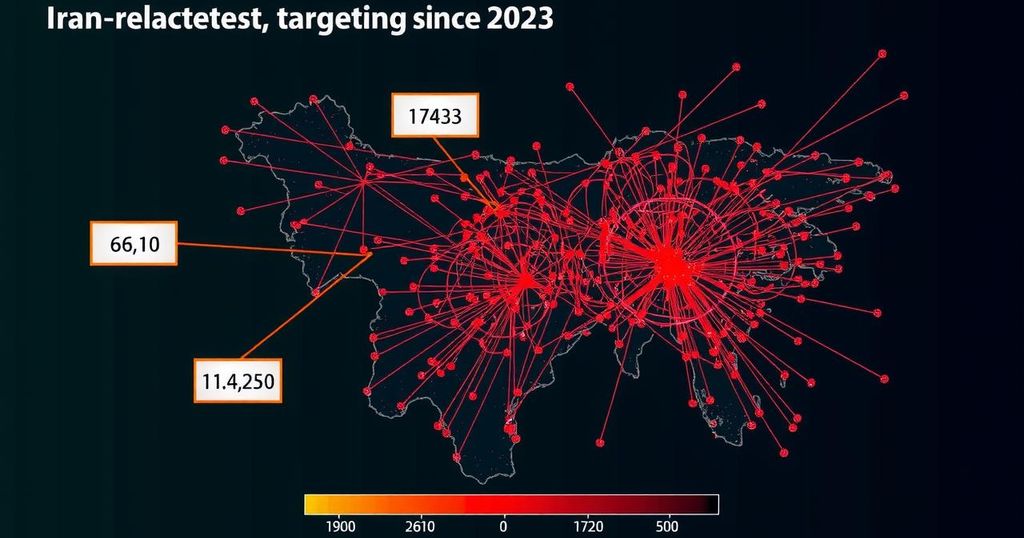Since the Hamas attack on Israel on October 7, 2023, attacks against the U.S. by Iran-linked groups have surged by 630%, primarily targeting U.S. personnel in Iraq and Syria. The report highlights over 204 hostilities involving rockets and drones against U.S. forces, correlating with intensified regional conflicts reflecting Iranian strategy to utilize proxies to exert pressure without direct confrontation.
As of late 2023, attacks against the United States by Iran-aligned groups have surged remarkably, with a staggering 630% escalation in hostile actions since the onset of the Hamas assault on Israel on October 7, 2023. This significant increase encompasses a variety of malign incidents, including projectiles, maritime confrontations, and cyberattacks. Following the aforementioned event, these Iranian-backed factions have intensified their assaults not only on Israel but also on U.S. troops in Iraq and Syria, as well as U.S. naval vessels facing threats from Houthi militants in Yemen. The ongoing confrontations have prompted U.S. military responses targeting Iranian militia positions as part of operations to mitigate threats posed by these groups. In the immediate aftermath of the October 7 Hamas assault, U.S. military analytics revealed an alarming trend. Iran-affiliated groups in Iraq and Syria reportedly launched over 204 attacks on American personnel, utilizing more than 330 rockets, missiles, and drones since mid-October 2023. The report elucidated that U.S. responses to these increasing threats have the potential to influence Iran’s decision-making regarding further aggression. Worth noting is that incidents of aggression from these militias have more than doubled in comparison to previous months. The JINSA report details that groups such as the Islamic Resistance in Iraq, acting as a coordinated entity for various Iranian proxies, have executed these strikes. Nonetheless, it is important to clarify that these incidents exclude interactions with irreconcilable actors like ISIS and the latest aggressions registered this week. Despite the increased hostilities, no U.S. personnel have been reported injured, as operational efforts aim to disrupt Iran’s capacity to orchestrate additional assaults. In a broader context, this escalation in attacks on U.S. forces directly corresponds with heightened hostilities against Israel, culminating in over 320 ballistic missiles and numerous UAVs targeted at the Israeli state by Iranian forces since the conflict escalated. It is evident that Iran seeks to exert pressure via its proxy armies, leveraging tactics that circumstantially position Iraq and Syria as platforms for hostilities without incurring direct retaliation on Iranian soil. Observers foresee an expansion in conflict involving these militias and Israel, driven by the necessity for Iran to sustain its influence and prevent a normalized retaliatory dynamic against its homeland.
The increase in attacks from Iran-linked actors towards U.S. forces and interests can be traced back to several geopolitical events, primarily the U.S. withdrawal from the Iran nuclear deal in 2018, which had already seen a rise in malignant activities against U.S. personnel. The situation escalated following the Hamas attack on Israel, which prompted Iran-aligned groups to leverage their offensive capabilities against both Israel and U.S. military assets in the region, indicating a coordinated effort to project power and influence through proxy warfare.
In conclusion, the escalation of attacks against the United States by Iran-linked militias exemplifies a significant shift in regional dynamics following the recent Hamas assault on Israel. This surge of 630% in hostile actions emphasizes the calculated strategy of Iran and its affiliates to destabilize U.S. interests while expanding their offensive capabilities via proxies in Iraq and Syria. As military operations continue to target these Iranian-backed groups, the broader geopolitical ramifications are likely to influence future U.S. military and diplomatic strategies in the region.
Original Source: www.foxnews.com






